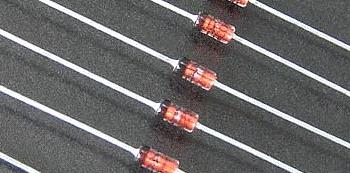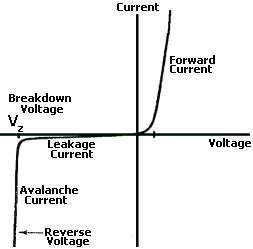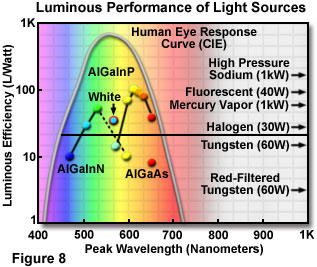In real how a diode looks like An LED is an electronic device that emits light when sufficient current flows throughout the object. We know that in each diode there is a recombination of electrons and holes. This recombination of electrons and holes releases some energy which is invisible in most of the diodes but in some diodes it is visible in the from of light. When light is emitted on forward biasing of a P N junction than it is known as electroluminance. In this way, the frequency of emitted light from the diode may be in visible spectrum or in invisible spectrum. Emitted light from the diode can be divided into two parts, (i) light which is visible to human and (ii) light which is invisible to human. The frequency range visible to a normal man is 400nm (nenometer) to 700nm (nenometer). Light is generally coloured in this range. The waves of light with wavelength below 400nm (nenometer) are known as ultraviolet and waves of light with length greater than 7(K)nm are known as infra red. Light emitted from LED depends upon two factors,
its a two terminal device
The circuit symbol for diode is
there are different types of diode....
Diode
Zenerdiode

Every diode leaks (allows a little amount of current to pass through) in the wrong direction, but when there is more then about 60 volts on the diode (in the blocking direction) it will let it all pass, and it often gets defective. This effect is used in zenerdiodes. In a zenerdiode the threshold is much lower, and the diode keeps working. Zenerdiodes are used a lot in power supplies to keep the voltage constant:LED
LED stands for Light Emitting Diode. This is a very special kind of diode, which produces light. They are available in many different colors: red, green, and yellow. There are also blue and white LEDs, but they are produced in another way, and are much more expensive. LEDs don't act like a normal light bulb, they are still diodes. This is the symbol of a led:

functions of diode
Diodes allow electricity to flow in only one direction. The arrow of the circuit symbol shows the direction in which the current can flow. Diodes are the electrical version of a valve and early diodes were actually called valves.
zener diode
A Zener Diode is a special kind of diode which permits current to flow in the forward direction as normal, but will also allow it to flow in the reverse direction when the voltage is above a certain value - the breakdown voltage known as the Zener voltage.![]()
The Zener voltage of a standard diode is high, but if a reverse current above that value is allowed to pass through it, the diode is permanently damaged. Zener diodes are designed so that their zener voltage is much lower - for example just 2.4 Volts. When a reverse current above the Zener voltage passes through a Zener diode, there is a controlledbreakdown which does not damage the diode. The voltage drop across the Zener diode is equal to the Zener voltage of that diode no matter how high the reverse bias voltage is above the Zener voltage.
The illustration above shows this phenomenon in a Current vs. Voltage graph. With a zener diode connected in theforward direction, it behaves exactly the same as a standard diode - i.e. a small voltage drop of 0.3 to 0.7V with current flowing through pretty much unrestricted. In the reverse direction however there is a very small leakage current between 0V and the Zener voltage - i.e. just a tiny amount of current is able to flow. Then, when the voltage reaches the breakdown voltage (Vz), suddenly current can flow freely through it.
Lighe Emitting Diode(LED)
working of diode
zener diode
Zener diode conducts just like a ordinary diode on forward bias. On reverse bias leakage current flows in it. This leakage current increases with the reverse voltage. This leakage current will increase suddenly after a definite reverse voltage. This voltage is known as break down voltage of zener diode or zener voltage and this sudden increase in current is known as zener current. For example, if a 6 volt capacity zener diode is connected in series with the 6 volt battery than the effect of forward and reverse bias will be as follows : There will be current flow in the zener diode in the position shown in the fig. 29A but there will be no flow of current in the zener diode in the position shown in the fig,29B. If now the battery voltage in the position of fig B is raised than there will be leakage current in the zener in the beginning. If reverse voltage are raised in steps than on a definite reverse voltage there will be suddenrise in the current in the zener, In the fig. 29C, the upper position of the graph shows the variations in forward current on forward voltage and lower position shows the effect onreverse current due to reverse voltage.300 ~| | |
light emmiting diode(LED)

The two wires extending below the LED epoxy enclosure, or the "bulb" indicate how the LED should be connected into a circuit. The negative side of an LED lead is indicated in two ways: 1) by the flat side of the bulb, and 2) by the shorter of the two wires extending from the LED. The negative lead should be connected to the negative terminal of a battery. LED's operate at relative low voltages between about 1 and 4 volts, and draw currents between about 10 and 40 mill amperes. Voltages and currents substantially above these values can melt a LED chip.The most important part of a light emitting diode (LED) is the semi-conductor chip located in the center of the bulb as shown at the right. The chip has two regions separated by a junction. The p region is dominated by positive electric charges, and the n region is dominated by negative electric charges. The junction acts as a barrier to the flow of electrons between the p and the n regions. Only when sufficient voltage is applied to the semi-conductor chip, can the current flow, and the electrons cross he junction into the p region.In the absence of a large enough electric potential difference (voltage) across the LED leads, the junction presents an electric potential barrier to the flow of electrons.
all about electronic device
Popular Posts
-
WorldWide Tech & Science. Francisco De Jes�s. NETGEAR Executives Discuss Future of Connectivity and Storage at Key January Conferences. ...
-
Massachusetts-based Art Technology offerings include e-commerce software and related IT services for online retail, travel, media, insurance...
-
WorldWide Tech & Science. Francisco De Jes�s. Austrian Felix Baumgartner jumps from a balloon 24 miles above Earth. Video. Austrian da...
-
WorldWide Tech & Science. Francisco De Jesùs. Video: Nokia Asha 305 dual SIM with 40 free EA premium games. Nokia Asha 305 http://nokia....
-
Switzerland's telecom service provider Swisscom is currently testing the LTE in Grenchen. According to the company statement, LTE is t...
-
WorldWide Tech & Science. Francisco De Jes�s. CES2013: Download the app for your mobile. USA and Canada only. You can download th...
-
WorldWide Tech & Science. Francisco De Jes�s. South Korea: LG takes on the iPhone 5 on newspaper ad. A newspaper advertisement b...
-
Colombian telecoms operator UNE EPM has planned to launch LTE services in three or four large cities during the second half of next year. Ac...
-
The critical part of the fm radio receiver is the first stage, TR1/VC1, where the wirings must be kept as short as possible. Coil L1 is form...
Blog Archive
-
▼
2011
(66)
-
▼
January
(30)
- DTMF (Dual-tone multi-frequency )
- ELECTRONIC SOFTWARES & BOOKS FREE DOWNLOAD
- DIODES
- SWITCHES
- BREAD BOARD
- LIGHT DEPENDENT RESISTORS(LDR)
- LIGHT SENSITIVE ALARM
- LED TORCH USING MAX660
- SIMPLE LIE DETECTOR
- SIMPLE FM RECEIVER WITH EAR PHONES
- MOBILE PHONE CHARGER
- WIRELESS SWITCH
- LASER ACTIVATED SWITCH
- RADIO WAVES DETECTOR
- FREE PCB DESIGN SOFTWARE
- MISCELLANEOUS ELECTRONICS SOFTWARE
- FM TRANSMITTERS (SIMPLE DESIGNS)
- TRANSFORMERS
- TOUCH SWITCH
- SIMPLEST RADIO
- AIR CRAFT RADIO COMMUNICATION RECEIVER
- K- MAPS SOFTWARE AND INTRODUCTION(karnaughs maps)
- SR-FLIP FLOP
- NETWORK THEOREMS
- UNI JUNCTION TRANSISTOR
- BIPOLAR JUNCTION TRANSISTOR (BJT)
- FIELD EFFECT TRANSISTOR (FET)
- SILICON CONTROLLED RECTIFIER (SCR)
- JFET
- MOSFET
-
▼
January
(30)
About Us
Hi world! I'm an enthusiast blogger within passion in electronics field.
Footer Widget 2
Footer Widget 3
Copyright © 2011 what is electronics | Powered by Blogger
Design by Free WordPress Themes | Bloggerized by Lasantha - Premium Blogger Themes | Eagle Belt Buckles








0 comments:
Post a Comment